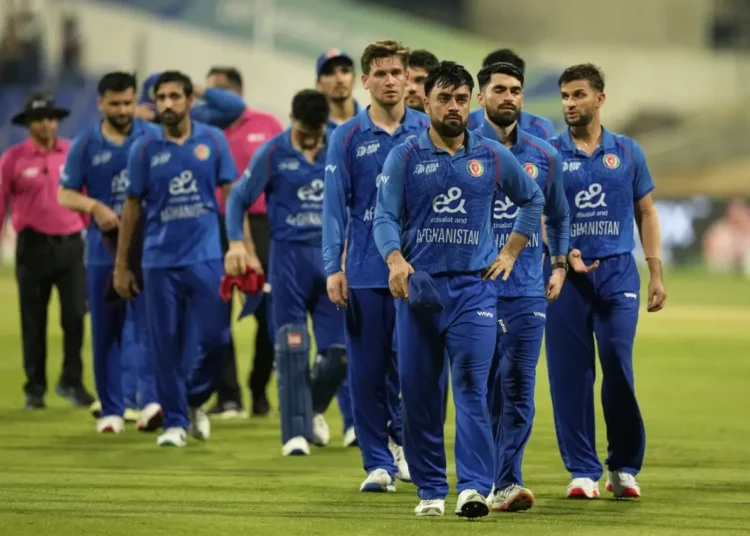Afghanistan won both powerplays. With the bat, they surged to 63/0 after 6, then recovered from a mid-innings wobble to plunder 50 in the last 4 overs. With the ball, they produced a five-wicket powerplay, effectively ending the chase inside 30 minutes. The template was simple and ruthless: front-foot intent + matchup bowling + elite death execution.
Match Snapshot
-
Result: Afghanistan 180/6 beat Zimbabwe 127 all out by 53 runs
-
Afghanistan: Ibrahim Zadran 52 (31), Gurbaz 39 (25), Omarzai 27 (21), Shahidullah 22* (13); Raza 3-20 for ZIM
-
Zimbabwe: Maposa 32 (15), Bennett 24 (13); Mujeeb 4-20, Omarzai 3-29 for AFG
-
Series: Afghanistan lead 1–0; now 17 wins in 19 T20Is vs Zimbabwe
-
Venue/Date: Harare, Oct 29, 2025
Phase-by-Phase: How the Game Tilted

Powerplay (Overs 1–6): Momentum Manufactured
-
Afghanistan batting: Only 6 off the first 11 balls, then a switch flipped—four boundaries in five balls. Gurbaz attacked square of the wicket; Zadran drove and pulled anything back of a length. Brad Evans’ 5th over went for 16, and AFG finished 63/0—the ideal T20 launch.
-
Zimbabwe batting: Bennett cracked three fours in the first over to hint at a chase… and then the storm hit. Mujeeb’s lbw + carrom-ball gold in the second over, Omarzai’s bounce and heavy-length in the 4th and 5th created three ducks in the top five. Zimbabwe slumped to a historically bad powerplay (their most wickets lost inside six in T20Is).
Middle Overs (7–15): Raza’s Riposte vs AFG’s Reset
-
Raza’s class: A one-run, double-strike over removed Zadran (52) and Rasooli off consecutive balls to make it 101/3 and stall AFG for 20 balls without a boundary.
-
Afghanistan’s counter: Sediqullah Atal broke the drought with a pull for six; although Muzarabani’s late double (Atal, Nabi) made it 130/5 (16), Omarzai and Shahidullah rebooted with smart pace-use and risk control.
Death Overs (16–20): 50-Run Uplift
-
Shahidullah’s finish: 22* off 13, mostly percentage strokes using the pace.
-
Omarzai’s glue: 27 off 21—low-risk twos, well-chosen swings.
-
Final ball: Rashid Khan lofted long-on for six to close at 180, a score that forced Zimbabwe to over-attack early—and into Mujeeb’s trap.
Bowling Blueprint: Why Afghanistan’s Attack Works Everywhere
Mujeeb ur Rahman: The Illusionist (4-20)
-
Carrom ball + length control: Identical arm speed, late dip, and stump-to-stump lines make pre-meditation hazardous.
-
New-ball menace: He attacks pads and top of off, then slips in the carrom when the batter commits to a swing arc. That’s how top-order hitters end up miscuing or playing around the ball.
Azmatullah Omarzai: The Tone-Setter (3-29)
-
Overs 1–6 role: After a leaky first over, he hit the deck harder, used the cross-seam, and went chest-high to the splice—Raza and Burl fell to hard-length and surprise bounce.
-
Two-skill value: Those new-ball wickets mattered as much as his late-overs batting. He essentially bookended the win.
Support Crew & Fielding
-
Abdollah Ahmadzai: seam-up poles and a direct-hit—Harare rewards straight, skiddy lengths when the ball’s harder.
-
Rashid Khan: didn’t even need a headline spell; his mere presence closed scoring options in the middle.
Batting Notes: What Afghanistan Did Right
Ibrahim Zadran’s Control (52 off 31)
-
Range without rashness: Down-the-ground percentages, midwicket drill for pace-on, glide against width. He handled back-of-a-length cleverly, never getting stuck.
-
Tempo: 31-ball fifty came right as Zimbabwe looked to squeeze—his boundary bursts punctured field traps.
Rahmanullah Gurbaz’s Role (39 off 25)
-
Field-manipulation: Early shuffle to create off-side access; cut and drive over point/cover forced deep third and cover back, opening singles.
Finishing Pair: Omarzai + Shahidullah
-
Shot selection: Low-trajectory drives and rolls into gaps, no across-the-line slog-fest until set. That discipline is why Afghanistan extracted 50 at the death without chaos.
Zimbabwe: Positives, Problems, Path Forward
Positives
-
Sikandar Raza (3-20): World-class control; his one-run, double-strike over flipped the innings for a spell.
-
Tinotenda Maposa (32 off 15 at No.9): Showed a clear method—target pace-on, use angle to access leg-side pockets; a handy late-order blueprint.
-
Evans–Maposa stand: Proved AFG’s fifth bowler can be milked if you pick the right matchups.
Problems
-
Top-order game plan vs spin: No clear plan for Mujeeb’s carrom ball. Too much pre-commitment to swing across the line.
-
Shot selection under pressure: Three ducks in the top five tell a story—hard length + indecision equals edges and mis-hits.
-
Powerplay collapse habit: Once early wickets fell, there was no throttle-down rebuild—only panic.
What Can Change by Oct 31 (2nd T20I)
-
Train the default: Play Mujeeb straighter; treat carrom like a hard length—present the full face, take one, live to the next ball.
-
Staggered intent: Use a “one enforcer, one absorber” template in PP—Bennett can attack, partner soaks.
-
Left-right switches: Force bowlers to reveal pace early; kill their preferred angle.
-
Spin to win in middle: Keep Raza for post-PP overs 7–12 where Afghans reset; bring a second spinner to pair lines (off-spin into the pocket, leg-spin wider).
Tactical Board: Why the Matchups Favoured Afghanistan
-
Zimbabwe seamers short of a length to Gurbaz/Zadran → cut/pull options unlocked, field pushed back, singles free.
-
Raza vs new batter → immediate wickets, but no follow-through partnership from the other end to extend squeeze.
-
Omarzai vs hitters → hard length into hip/ribs; miscues to leg-side catcher in ring.
-
Mujeeb vs pre-commit hitters → carrom ball punished swing-first mindset; Zimbabwe needed a ‘late hands’ plan and didn’t have one.
Selection & Strategy Watch for Game 2
Afghanistan
-
If defending again: Keep Mujeeb two upfront overs; save one for post-PP to hit incoming right-handers.
-
Batting order: Float Shahidullah to No.6 ahead of Nabi when pace-on is prevalent; his pace-use was superb.
-
New-ball share: Back Omarzai with an aggressive ring (two catchers leg-side) to reward the bouncer plan.
Zimbabwe
-
Top-order tweak: Consider a stabiliser at No.3 who plays V-shaped strokes; protect Raza for the middle where he flips games.
-
Bowling plans to Zadran/Gurbaz: Less “hip-high” pace-on; more wide yorkers and back-spun cutters into the pitch.
-
Death batting roles: Promote Maposa one spot earlier if platform exists—he’s shown the gears.
Key Numbers

-
AFG PP score: 63/0
-
AFG last 4 overs: 50 runs
-
ZIM PP wickets lost: 5 (their worst in a T20I powerplay)
-
Mujeeb: 4-20 (two in first spell, two to close)
-
Omarzai: 27 (21) + 3-29
-
Zadran: 52 (31) — 31-ball fifty
-
Maposa: 32 (15) — lower-order surge
Context & Undercurrents: Milestones and Motivation
-
Rashid Khan is closing in on a landmark tally of 500 T20 appearances; his workload management since back surgery has sharpened his control. Even without a headline haul here, his lanes suffocated Zimbabwe’s middle.
-
Graeme Cremer’s return adds curiosity and control to Zimbabwe’s spin stocks; if he plays, pairing his wrist-spin with Raza’s off-spin could create a genuine middle-overs choke.
Afghanistan didn’t need a perfect night; they needed the phases that matter. They won four of six: PP bat, PP ball, death bat, new-ball strike. That’s a traveling template—conditions agnostic, matchup-driven. The bench strength is real (Shahidullah stepping in after two years) and the roles are crystal clear.
Conclusion: Same Storyline, Sharper Edges
Afghanistan’s 53-run win wasn’t just dominance—it was a systems victory.
-
With the bat, a fearless PP, then composure, then clinical finishing.
-
With the ball, Mujeeb’s deception boxed in the chase, Omarzai’s hostility ripped out the core, and the support cast tidied up.
-
For Zimbabwe, there are green shoots—Raza’s spell, Maposa’s spark—but the powerplay plan and spin method need immediate fixes.
Game 2 on October 31 is less about wholesale changes and more about discipline under pressure. If Zimbabwe can delay Afghanistan’s control of the early overs and deny Mujeeb free looks at pre-meditated swings, the series tightens. If not, Afghanistan’s track record—and their ruthless phase control—will likely push them to 2–0.





